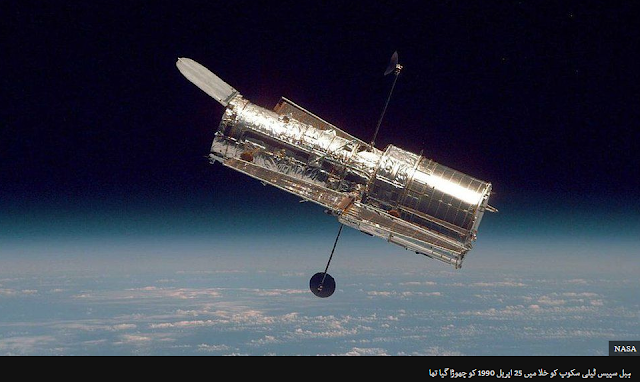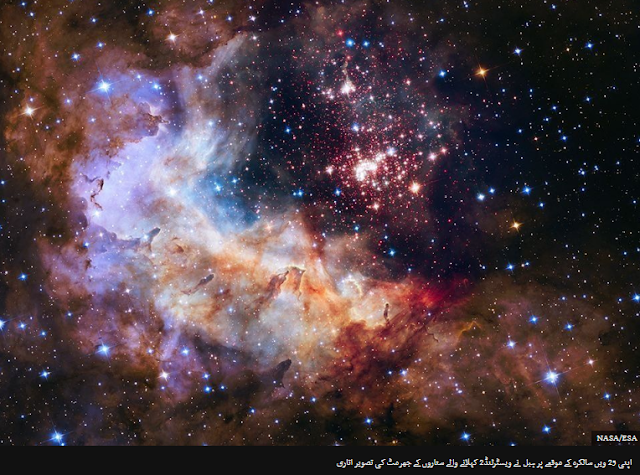That was 30 years ago when the Hubble Telescope was launched into space. In celebration of his birthday, this historical telescope has presented another amazing picture of the universe.
It is located 163,000 light-years from Earth in the part of space where stars form.
The big thing to look at is NGC 2014, a cloud of gases and dust, with NGC 2020 in its neighborhood.
But astronomers have dubbed it the 'Cosmic Reef' because of its resemblance to the ocean floor.
When it was launched into space in 1990, it did not receive the status it deserved for its blurry images, but Hubble was later repaired and modernized.
Also read
Will NASA's telescope be able to track space creatures?
'Discovered the planet on the third day of the internship'
How are planets created? A change in the old ideology
The images he has made of planets, stars and galaxies have changed man's perception of space.
Of course, there are those who believe that the Hubble Telescope is the most important scientific instrument ever invented.
It is still a long way from retirement.
NASA, the US space agency that runs the telescope mission in collaboration with the European Space Agency (ESA), says it will continue to be funded as long as its usefulness remains in place.
More than a thousand scientific articles were published last year based on images and data obtained from this telescope, so it is still important for scientific discoveries.
Engineers are constantly monitoring the various systems and functions of this telescope.
Satisfactorily, all four of its instruments, including two 'imagers' or cameras and two 'spectrographs' analyzing the light of the planets, are working perfectly.
In the past, the telescope's six gyroscopes, or rotations, have been one of its weaknesses, whose job is to help it change direction and keep it still like a rock when taking pictures of its targets.
These gyroscopes have been deteriorating from time to time.
During the last mission to repair the Hubble Telescope in 2009, astronauts were instructed to replace six of the six instruments.
Since then, three gyroscopes have been shut down, but NASA project scientist Dr. Jennifer Weizmann says this is not a cause for concern.
He says the work is usually done through three gyroscopes. But because of the expertise of the engineers, the Hubble Telescope can be operated by one.
Everyone is confident that Hubble will continue to operate in the 2020s.
It will be succeeded by the James Webb Space Telescope, which is scheduled to be launched into space next year.
The presence of another modern telescope in space will increase Hubble's usefulness and will not diminish its importance. This is because the new telescope is designed to reflect the universe at a greater wavelength than Hubble.
This means that the James Webb Telescope will be able to capture things in its cameras that are beyond the reach of Hubble's cameras.
The two telescopes will improve each other's work and sometimes look at the same target together to get a more complete picture.
This is very exciting for scientists, and Dr. Antonella Nota, a project scientist at the European Space Agency, says this will be especially true for European scientists where Hubble has benefited greatly.
He told BBC News: "Under the preconditions for this project, European astronomers were to be given 15 per cent of the time to observe space through Hubble, but in reality they got 22 per cent. And the whole process is closely monitored, so we never need to point it out. European astronauts have creativity, they are intelligent and they are at the forefront of space research.
What did science get because of Hubble?
This has been said many times, but it is a fact that Hubble is a machine of discovery.
Before this telescope was sent into space in 1990, scientists did not know that our universe is 10 billion years old or 20 billion years old.
Hubble has helped to reduce this uncertainty by twinkling stars like a lighthouse or a lighthouse, and we now know that the universe is 13.8 billion years old.
Thanks to this telescope, it is known that the universe is not only expanding but also increasing in speed, and this discovery was awarded the Nobel Prize. Based on the same telescope, there was also solid evidence that there are very large black holes at the center of galaxies.
It is also astonishing that before the Hubble Telescope was sent into space, scientists could not detect a single planet or 'exoplanet' outside the solar system.
Today, Hubble is observing the atmosphere of these distant worlds in order to assess the conditions there.
Now, although the glowing eight-meter-large ground telescope can surpass or surpass Hubble in some areas, it is unparalleled in some areas of research and has no competition in peeking into the depths of space. Can
Deep field observations, in which a specific part of the sky can be seen continuously for several days, have helped identify very distant and extremely dim galaxies, making it the largest astronomical galaxy in the world. One of the achievements.
This study reveals what our universe looked like a few million years after the Big Bang.
The James Webb Space Telescope, which will be sent into space next year, will be able to see even deeper with the help of devices that can see the lower red rays.
Catherine Sullivan was among the astronauts who launched the Hubble Telescope into space on April 25, 1990 at an altitude of 612 km. All these memories he has accumulated in his new book Handprints on Hubble.
He says Hubble has had a profound effect on science.
Speaking to the BBC, he said: "But what he realized while writing his book was the beautiful images he had obtained from Hubble and his perceptions of space with confusing results. How are they embedded in our culture?
"I see pictures of Hubble in advertisements, on shirts, on lunch boxes, on body tattoos and everywhere. I think one of the reasons is that Hubble started its work at a time when the Internet was taking the shape we know it today. And because of that, all these pictures have come straight to the people.







Post a Comment